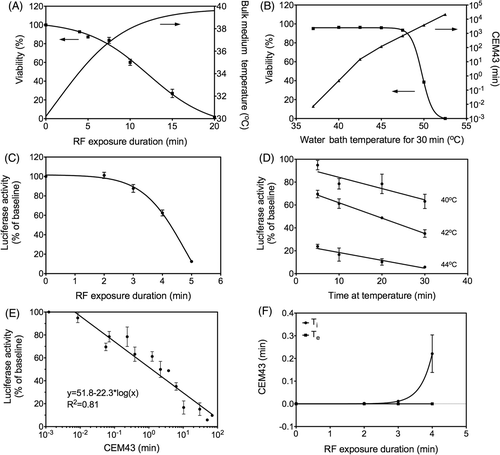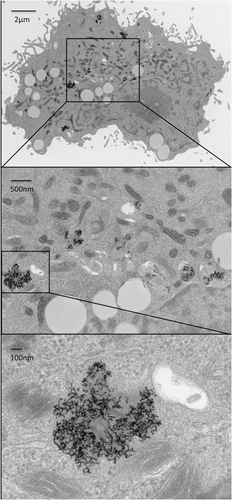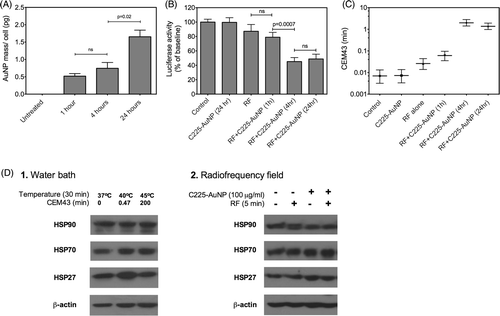Figures & data
Figure 1. Quantification of thermal dose in cells treated with RF without C225-AuNPs. (A) Loss of cell viability in SNU449 cells exposed to an RF field (13.56 MHz, 600 W) for varying durations with the corresponding bulk medium temperature (n = 3, symbols represent the mean ± SEM). (B) Loss of cell viability in cells exposed to water bath at varying temperatures for 30 min with corresponding calculated thermal dose. (n = 3, symbols represent mean ± SEM). (C) Loss of luciferase activity in SNU449 cells with increasing duration of RF exposure (n = 3, symbols represent the mean ± SEM). (D) Time- and temperature-dependent loss of luciferase activity after thermal exposure of SNU449 cells in a water bath (n = 3, symbols represent the mean ± SEM). (E) Thermal dose (CEM43) was calculated from data shown in and plotted against measured luciferase activity to generate a standard curve. (F) Using the standard curve (), intracellular thermal dose, CEM43 (Ti) was calculated for data shown in . Extracellular thermal dose (Te) due to bulk medium temperature was calculated from measured bulk temperatures and was found to be negligible (n = 3, symbols represent the mean ± 95%CI).

Figure 2. Quantification of thermal dose in cells treated with C225-AuNPs. (A) Preincubation of SNU449 cells with C225-AuNPs (100 µg/mL) for 4 h followed by RF exposure enhances thermal denaturation of luciferase. (B) Intracellular thermal dose (Ti) was quantified using the standard curve in . Extracellular thermal dose (Te) due to bulk medium temperature was calculated from measured bulk temperatures and was found to be negligible (n = 3, symbols represent the mean ± 95%CI). (All p values are from unpaired two-tailed t-test.)

Figure 3. Gold nanoparticle internalisation by SNU449 cells. Transmission electron microscopy images demonstrating uptake of C225-AuNPs (100 µg/mL) by SNU449 cells after 4 h of treatment.

Figure 4. Uptake of C225-AuNPs and their biological effects. (A) Intracellular amount of Au in each SNU449 cell as determined by ICP-MS increases with increasing duration of exposure to C225-AuNPs (100 µg/mL) (n = 3, bars represent the mean ± SEM). (B) Loss of luciferase activity in SNU449 cells incubated with or without C225-AuNPs (100 µg/mL) for varying duration followed by exposure to RF field for 3.6 min (n = 3, bars represent the mean ± SEM). (C) Relationship of duration of SNU449 cells incubation with C225-AuNPs (100 µg/mL) and intracellular thermal dose (same data as after intracellular thermal dose calculation using the standard curve in ) (n = 3, symbols represent the mean ± 95%CI). (D) Heat shock proteins were analysed using western blot immediately after thermal exposure in a water bath (1) or radiofrequency field (2). (All p values are from unpaired two-tailed t-test.)
